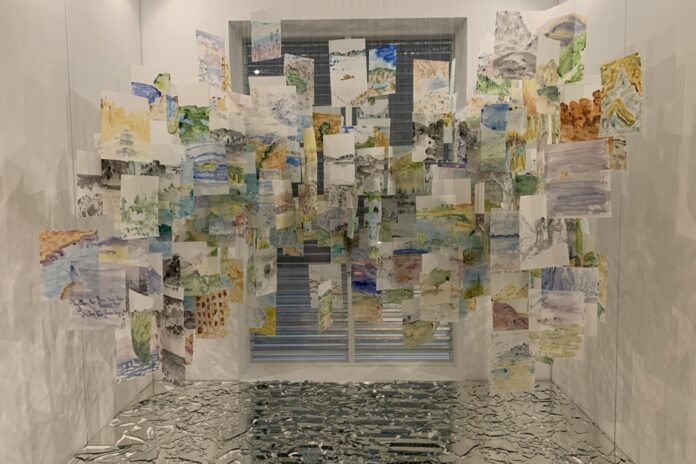The exact title of Aïda Vosoughi’s work is Displaced Landscapes II. This is a set of 360 maps that feature places that no longer exist. The artist of Iranian origin, who has lived and worked in Montreal for eight years, is interested in these places that have been destroyed or “radically transformed” by humanity. In doing so, there is no longer anyone living there – or almost no more. And in the performances of Aïda Vosoughi, everyone left.
“The main subject, in fact, is humans,” explains the artist, “but we don’t see it. »
By working with fluid acrylic on vellum paper which lets the paint slide rather than absorbing it, the landscapes become blurred. As, at a given moment, in the memory of those who knew them before they were destroyed.
The statement is harsh for a work which is very gentle.
The contrast is not trivial: in Iran, explains Aïda Vosoughi, the visual arts benefit from greater creative freedom, because one can evoke, symbolize and represent in such a way that everything is interpretation.
“We can say that it’s very poetic, not political,” continues the artist. For me, artistic creation begins with a political question. There is no such thing as art without politics. »
Note the mirror pieces under the mobile. It is a symbol of destruction. We can also see the reflection of images in mirrors as reflections on water, and it is often water that is the source of destructive conflicts. “Lack of water or poor water management,” explains the designer.
Aïda Vosoughi began this work on Displaced Landscapes in 2021, during the Baie-Saint-Paul Symposium.
The artist and his work also had a residency at Espace Adélard, in Frelighsburg, this fall.
Aïda Vosoughi came to Quebec in 2014, after five years of trying to leave Iran. Her Quebec journey is punctuated by wonderful encounters which have helped her in her creation and the dissemination of her works, like Sylvie Lacerte, the curator of the Riopelle exhibition, at the crossroads of times. “Sylvie supported my practice from the first exhibition I had in Montreal,” explains Aïda. The same goes for the Espace Adélard team, which is part of this “beautiful community”, which takes risks with emerging artists, believes the designer. “I feel very lucky and privileged to have met these people. »
The designer is conducting research in France for an upcoming project on immigration. She will spend a total of six weeks there, observing around the Channel, “where the issue of immigration is very present”.
She does not do journalistic work, even if she goes in search of stories, to meet people who will allow her to construct a fiction.
“I put up this barrier, not to use the narrative of others for my own work,” specifies Aïda Vosoughi, who is particularly affected by this dehumanization of migrants.
The work or works will be made upon his return to Quebec.
The work Displaced Landscapes II is part of the Riopelle retrospective at the National Gallery of Canada on view until April 7, 2024; then, at the Winnipeg Art Gallery, from June 1 to September 29, 2024.





